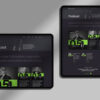It usually starts harmlessly. A reference to a game changer, a link to a new AI tool, a recommendation in a chat, an enthusiastic video on social media. The reflex is always the same: click, register, try it out in the hope of gaining a decisive advantage this time or finally finding the perfect solution.
What begins as curiosity quickly turns into inner competition.
You hardly notice how the beat gets faster. Before you’ve even tried one thing, the next one is already pushing its way through your feed. Colleagues send links with the question: “Tried it out yet?” – Customers expect to know how it works straight away. The industry celebrates its early adopters and sells tool tests as innovation.
At some point, the feeling changes.
Between registration and the tutorial, the game becomes overwhelming. The list of open accounts grows, but the actual progress remains manageable. Results from promotional videos and showcases seem like magic, but in everyday life, there is rarely any relief. On the contrary: the promise of automation and shortcuts creates new pressure – to keep pace, compare, keep up. The actual aspiration to create solutions is in danger of disappearing in the noise of innovations.
What is easily overlooked:
It’s not the new tools or products that are the problem. It is the mechanism that turns us into consumers of an endless parade of tools – and tempts us to constantly look for the next miracle instead of taking a step back and setting our own direction again.
As soon as a new device, AI model or software tool is announced, the ritualized race begins in the agency and marketing world: Who will be the first to recognize the next game changer? Who has already tried out the tool, who will write the first case study?
Innovation becomes a compulsory exercise, a staging of future competence – and often a substitute for the absence of far-reaching changes. The price of the tool becomes the headline, the command to try it out becomes an act of innovation. But the really crucial questions – what does this mean for our value creation, our autonomy, our structures? – usually remain unanswered.
Game changer or just another new tool?
Why the hype culture hides the real change
Hype is convenient. “Gamechanger” has become the favorite word of an industry that longs for transformation but is rarely willing to truly renew structures.
The inflationary proclamation of game changers – usually for tools, features, updates – serves as a socially accepted excuse to remain loyal to old systems and postpone real change. It is much easier to talk about disruption than to tackle the laborious reorganization in the engine room of your own organization.
This is precisely where the risk lies
The loud discourse about the “new” becomes a stage on which many spectators of their own production remain instead of becoming actors of change. Attention is focused on announcements, prizes and potential – but rarely on the actual forces at work beneath the surface.
A real game changer is not a feature or an app. It is the tectonic shift in the rules of the game itself – a new infrastructure, a changed logic of visibility, value creation and influence.
As long as the discourse remains on the surface, the actual transformation remains hidden. Those who fail to recognize how and where the foundations are shifting run the risk of celebrating everything new – but end up remaining spectators of the actual revolution.
How to escape the reflex – and become a designer again
The truth is inconvenient
Today, all digital communication – from content to service, from marketing to product development – revolves almost exclusively around the input interface.
This has given rise to an entire profession: UX designers, conversion optimizers, interface specialists. But the actual operating system of change remains in the shadows: The way in which information, functions and dialogs are made accessible to machines and agents.
What are we really talking about?
We are at the beginning of an era in which the interface is disappearing and value creation is taking place in the invisible layers: AI agents, voice control, open interfaces and structured data are not only changing user behavior – they are shifting the center of power in digital communication.
It is no longer the human who clicks, but the machine that delegates, filters, decides and presents.
What follows from this?
Those who only focus their energy on the surface today will remain spectators of the coming paradigm shift.
The next generation of visibility, reach and influence will be determined by those who now design their content, services and processes to be machine-readable, API-compatible and agent-enabled.
That is the real game changer:
Only those who start to structure communication for machines instead of people will remain present on the output side – and will still play a role at all when agents, voice systems and invisible interfaces determine everyday life. The rest are watching the change – and find themselves on the invisible back side of the new digital infrastructure.

io as an anchor of the present – The invisible interface and the real turning point
With the launch of io – an inconspicuous device that acts as a “friend and listener” – the digital revolution is shifting once again: interaction is finally moving from the visible surface to the background, to dialogue, to silent delegation.
Machine readability in images – how the new user experience is created
Let’s imagine the digital world of tomorrow in two familiar everyday scenes:
Scene 1: Planning the trip
Someone sits at the computer for hours, juggling with hotel portals, car rental providers, insurance companies and flight booking sites. Every booking is a new form, every step a change of context, laborious searching, constant copying and matching. The goal: the perfect vacation – but how to get there? Frustrating.
In the new world, an AI agent takes care of all the planning on demand: “Book a trip for me along the Loire, seven days, four stopovers, only hotels with parking, please also book a rental car and the right insurance.”
The machine recognizes preferences, asks questions, closes gaps – and presents the finished package. No lost control, because the dialog remains open at all times: You can ask questions, reschedule, weigh up, decide.
Machine-readable data and functions make it possible for agents to understand, compare and negotiate systems – instead of working their way through opaque interfaces.
Scene 2: Window shopping and the pleasure principle
Surfing for hours, discovering new collections, comparing designs, browsing through offers without any intention. The appeal: inspiration, discovery, perhaps the surprise of the unplanned.
This also remains the same – and is even getting better: the AI agent knows moods, can curate, show trends, but always leaves room for chance.
You can express the desire to simply browse without any pressure to buy. But as soon as “looking” becomes “wanting”, attention is focused – the systems are prepared, data is clear, products are comparable and functions can be triggered directly.
What they have in common:
Both worlds – the targeted processing of tasks and unintentional browsing – will only function smoothly in the future if the underlying data, offers and functions are structured in such a way that they can be interpreted, linked and controlled by machines. For users, the boundary between interface and infrastructure will become invisible – what is crucial is that the transition remains possible at all times, without media discontinuity, without loss of control, without frustration.
What does that mean in concrete terms?
- Machine readability is not a technocratic idea. It is the prerequisite for digital systems to truly master the balancing act between efficiency and experience, between mission and inspiration.
- Only those who make their communication, their offers and their content machine-readable will remain visible – in the dialog between agents and in the window of the curious.
- If you only take care of the input interface, you build the shop window – but not the warehouse, not the delivery route, not the customer experience of tomorrow.
What does this mean for you – and what do you need to do now?
For decision-makers, entrepreneurs and brand managers:
If you want your offers, content and services to be findable, comparable and bookable in a world of the agent economy, you need to act now.
Don’t wait for a “miracle tool” to secure the connection. Machine readability is not achieved by another interface upgrade, but by a conscious decision to structure your own data, functions and processes in such a way that they can be connected to machines – and therefore to the entire market.
- Check your website, your content, your booking and contact channels for machine readability: Are offers clear, are products and services clearly structured, are APIs available?
- Promote networking – in the system, not just in marketing.
- Think of communication as a system, not as a campaign.
Anyone who hesitates now will soon be overtaken by those who think systemically and recognize the engine room as a new playing field.
For competitors, consultants, agencies:
You have understood that the battle for visibility is no longer decided on the surface. The future of your customer relationships, your own offering and your competitiveness lies in the ability to build machine-readable solutions – and to enable customers to do so.
- Get out of the comfort zone of classic UX and front-end optimization.
- Invest in structuring, automation, semantic data models, interface know-how.
- Offer not just beautiful pages, but architectural visibility – for people and machines.
- Help your customers to model their offers in such a way that they remain visible and controllable in an agent economy.
Only those who anticipate now are not just service providers later, but remain designers – and become strategic partners as competence leaders.
”From now on, those who understand the rules of the new visibility will separate themselves from those who are still decorating the shop window. Machine readability is no longer a feature - it is the operating system of your relevance.
Norbert Kathriner
Link tips
Brand management through AI-supported SEO
Becoming visible in ChatGPT – The guide to AI visibility
The problem with traditional SEO agencies








